Use Case C1 - Customer reduces their Usage in response to Pricing or Voluntary Load Reduction events
《跨境电子商务英语》教学课件(共8单元)Unit 2
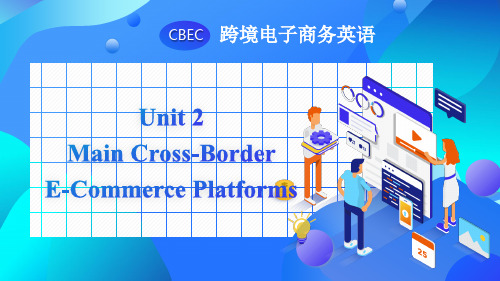
Warming-up Activities
Conversation
B: Quite reasonable. What products are you going to sell? A: The bags and shoes. To be specific, men’s, women’s and teenager’s dress, shoes, sneakers and sandals. B: It’s great. As far as I am concerned, what you have to do next is setting up your online store on a platform. A: I’ve heard some e-commerce platforms, but I am not familiar with them. B: Then you need to do a survey about these platforms to compare their advantages and disadvantages. A: That’s right. That’s what I should do.
New Words and Phrases
8. distributor /dɪ'strɪbjətə(r)/ n. 经销商;分销商 9. branch /bra:ntʃ/ n. 分公司;分支;分部 10. brainchild /'breɪntʃaɪld/ n. 发明;新构想 11. franchise /'fræntʃaɪz/ n. 特许;(公司授予的)特许经 销权 12. straightforward /ˌstreɪt'fɔ:wəd/ adj. 简单的;易懂的 13. submit /səb'mɪt/ v. 提交 14. approval /ə'pru:vl/ n. 批准;同意
UseCase—的案例学习

供应链管理及业务管理知识分析模式(英文版)
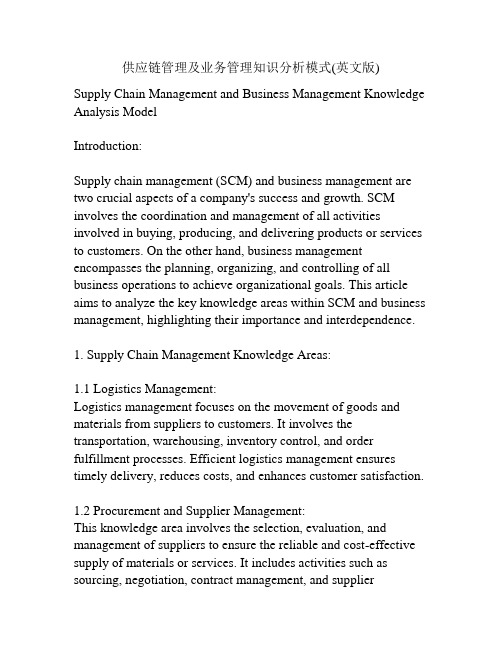
供应链管理及业务管理知识分析模式(英文版) Supply Chain Management and Business Management Knowledge Analysis ModelIntroduction:Supply chain management (SCM) and business management are two crucial aspects of a company's success and growth. SCM involves the coordination and management of all activities involved in buying, producing, and delivering products or services to customers. On the other hand, business management encompasses the planning, organizing, and controlling of all business operations to achieve organizational goals. This article aims to analyze the key knowledge areas within SCM and business management, highlighting their importance and interdependence.1. Supply Chain Management Knowledge Areas:1.1 Logistics Management:Logistics management focuses on the movement of goods and materials from suppliers to customers. It involves the transportation, warehousing, inventory control, and order fulfillment processes. Efficient logistics management ensures timely delivery, reduces costs, and enhances customer satisfaction.1.2 Procurement and Supplier Management:This knowledge area involves the selection, evaluation, and management of suppliers to ensure the reliable and cost-effective supply of materials or services. It includes activities such as sourcing, negotiation, contract management, and supplierperformance measurement.1.3 Demand Planning and Forecasting:Demand planning and forecasting involve the estimation of future customer demand for products or services. It helps in the optimization of inventory levels, production planning, and resource allocation. Accurate forecasting reduces stockouts, minimizes inventory carrying costs, and improves customer service.1.4 Inventory Management:Inventory management encompasses the control and optimization of inventory levels to meet customer demands while minimizing holding costs. It includes inventory classification, safety stock determination, replenishment strategies, and utilization of advanced inventory management techniques like just-in-time (JIT) and economic order quantity (EOQ).1.5 Risk Management:Supply chain risk management involves identifying, assessing, and mitigating risks associated with supply chain operations. It includes evaluating risks related to supplier reliability, demand volatility, transportation disruptions, natural disasters, and geopolitical factors. Effective risk management helps in minimizing potential disruptions and ensuring business continuity.2. Business Management Knowledge Areas:2.1 Strategic Planning:Strategic planning involves setting the long-term goals and direction of the company. It includes analyzing internal andexternal factors, conducting market research, defining the company's mission and vision, and formulating strategies to achieve competitive advantage. Strategic planning provides a roadmap for decision-making and resource allocation.2.2 Financial Management:Financial management focuses on the efficient utilization and allocation of financial resources within the company. It includes budgeting, financial analysis, cash flow management, and capital investment decisions. Effective financial management ensures profitability, liquidity, and sustainability of the business.2.3 Organizational Behavior:Organizational behavior refers to understanding individual and group dynamics within the company. It includes topics like motivation, leadership, communication, team dynamics, and organizational culture. Understanding and managing organizational behavior promotes employee engagement, productivity, and effective teamwork.2.4 Marketing and Sales Management:Marketing and sales management involves the identification of target markets, development of marketing strategies, and implementation of promotional activities to achieve sales objectives. It includes market research, product development, pricing, distribution, and customer relationship management. Effective marketing and sales management drive customer acquisition, retention, and revenue generation.2.5 Operations Management:Operations management focuses on the design, control, and improvement of production processes to deliver products or services efficiently. It includes capacity planning, production scheduling, quality management, and continuous process improvement. Effective operations management increases productivity, reduces costs, and ensures customer satisfaction.Conclusion:Supply chain management and business management are interconnected and essential for the success of any company. A comprehensive knowledge analysis model helps to identify and prioritize key knowledge areas within these domains. Companies that effectively manage their supply chains and employ sound business management principles gain a competitive edge, achieve operational excellence, and sustain long-term growth and profitability.3. Interdependence between Supply Chain Management and Business Management:The interdependence between supply chain management and business management is crucial for the overall success and growth of a company. While supply chain management focuses on the operational aspects of sourcing, production, and delivery, business management provides the strategic framework and direction for these activities. The knowledge areas within both domains are interconnected and rely on each other for effective decision-making and implementation.For example, strategic planning plays a significant role in both supply chain management and business management. A company'sstrategic objectives and goals influence its supply chain strategy, such as sourcing strategies, selection of suppliers, and distribution network design. On the other hand, the company's supply chain capabilities and constraints impact its overall strategic decisions, such as market entry strategies, product differentiation, and pricing.Similarly, financial management is essential for both supply chain management and business management. Efficient financial management helps in allocating resources effectively within the supply chain, such as optimizing inventory levels, implementing cost-saving measures, and improving cash flow. It also enables the company to make informed business decisions, such as investing in new technologies or expanding into new markets.Organizational behavior plays a critical role in both domains as well. Effective communication, teamwork, and leadership within the supply chain contribute to smooth coordination and collaboration among various stakeholders. In business management, understanding organizational behavior helps in creating a positive work culture, motivating employees, and fostering innovation, thereby leading to better business performance and customer satisfaction.Marketing and sales management are interconnected with supply chain management as well. Market research and customer insights are crucial in demand planning and forecasting, which informs supply chain decisions, such as production levels, inventory management, and transportation requirements. Conversely, supply chain capabilities influence marketing and sales strategies, such as product availability, delivery speed, and customer service levels.Integration between these knowledge areas ensures alignment between supply and demand, resulting in customer satisfaction and competitive advantage.Furthermore, operations management plays a key role in both supply chain management and business management. Efficient operations management techniques, such as lean manufacturing, Six Sigma, and total quality management, improve productivity, reduce waste, and enhance product/service quality. These improvements, in turn, enhance the company's overall performance and competitiveness. Additionally, operations management principles help in optimizing supply chain processes, such as production scheduling, inventory management, and order fulfillment, leading to cost savings, shorter lead times, and improved customer satisfaction.4. Importance of Supply Chain Management and Business Management Knowledge:The knowledge areas within supply chain management and business management are crucial for companies to remain competitive, adapt to changing market dynamics, and drive overall business success. Below are the key reasons why companies should prioritize and invest in these knowledge areas:4.1 Optimal Resource Utilization:Efficient supply chain management ensures optimal utilization of resources, such as raw materials, production capacity, and transportation, resulting in cost savings and improved profitability. Likewise, effective business management helps in allocatingfinancial, human, and technological resources to their best possible use, maximizing the value generated by the company.4.2 Enhanced Customer Satisfaction:Supply chain management focuses on meeting customer demands by ensuring the availability of products/services, on-time delivery, and quick response to customer queries. This improves customer satisfaction and loyalty. Business management, meanwhile, helps in developing effective marketing and sales strategies, understanding customer preferences, and delivering superior customer service, further enhancing customer satisfaction and building long-term relationships.4.3 Risk Mitigation and Resilience:Supply chain management knowledge areas, such as risk management and procurement, help in identifying and mitigating potential risks to the supply chain, including disruptions from suppliers, transportation issues, or natural disasters. Business management complements these efforts by implementing suitable risk management strategies at the organizational level, such as diversifying revenue streams, implementing robust financial controls, and building strong relationships with key stakeholders. This ensures business continuity and resilience.4.4 Competitive Advantage:Companies that excel in supply chain management gain a competitive advantage by offering better value to customers through lower costs, higher product quality, and faster delivery. Similarly, effective business management, through strategic planning, marketing, and operations, helps companies differentiatethemselves from competitors and create unique value propositions that attract and retain customers.4.5 Innovation and Agility:Both supply chain management and business management knowledge areas foster innovation and agility within organizations. Supply chain innovation, such as implementing advanced technologies like automation, AI, and IoT, improves operational efficiency, reduces costs, and enables faster response to market changes. Business management knowledge areas, such as strategic planning and organizational behavior, help in creating a culture of innovation, driving continuous improvement, and fostering agile decision-making.Conclusion:Effective supply chain management and business management are critical for the success of any company. The knowledge areas within these domains are interconnected and mutually dependent. Companies that prioritize and invest in these knowledge areas gain a competitive edge, achieve operational excellence, and sustain long-term growth and profitability. Understanding and implementing the key principles and practices within supply chain management and business management enable companies to optimize resources, enhance customer satisfaction, mitigate risks, and leverage opportunities for innovation and competitive advantage.。
服务计划的名词解释英语
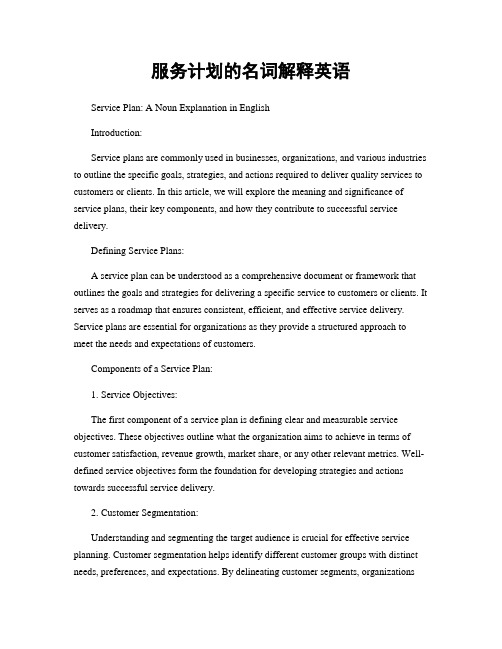
服务计划的名词解释英语Service Plan: A Noun Explanation in EnglishIntroduction:Service plans are commonly used in businesses, organizations, and various industries to outline the specific goals, strategies, and actions required to deliver quality services to customers or clients. In this article, we will explore the meaning and significance of service plans, their key components, and how they contribute to successful service delivery.Defining Service Plans:A service plan can be understood as a comprehensive document or framework that outlines the goals and strategies for delivering a specific service to customers or clients. It serves as a roadmap that ensures consistent, efficient, and effective service delivery. Service plans are essential for organizations as they provide a structured approach to meet the needs and expectations of customers.Components of a Service Plan:1. Service Objectives:The first component of a service plan is defining clear and measurable service objectives. These objectives outline what the organization aims to achieve in terms of customer satisfaction, revenue growth, market share, or any other relevant metrics. Well-defined service objectives form the foundation for developing strategies and actions towards successful service delivery.2. Customer Segmentation:Understanding and segmenting the target audience is crucial for effective service planning. Customer segmentation helps identify different customer groups with distinct needs, preferences, and expectations. By delineating customer segments, organizationscan tailor their services to cater to each group's specific requirements, thereby enhancing customer satisfaction and loyalty.3. Service Strategies:Service strategies are the overarching plans that guide the organization's approach to deliver the desired service outcomes. These strategies may include aspects such as pricing, product differentiation, service quality, or customer experience. Effective service strategies ensure that the organization's offerings are competitive, relevant, and meet the evolving needs of customers.4. Action Plans:An action plan outlines the specific steps and activities required to implement the service strategies and achieve the service objectives. It includes detailed timelines, responsibilities, and resources needed for successful execution. Action plans also enable organizations to track progress, monitor performance, and make necessary adjustments if required.Benefits of Service Plans:1. Consistency in Service Delivery:Service plans promote consistency in service delivery by providing a standardized approach and guidelines for employees. With a clear roadmap, employees can understand their roles, responsibilities, and the expected level of service quality. This consistency helps build trust and confidence among customers, leading to better customer experiences and long-term relationships.2. Enhanced Customer Satisfaction:By tailoring services to the specific needs and expectations of customer segments, service plans contribute to enhanced customer satisfaction. When organizations understand and meet customer needs effectively, it increases customer loyalty and reduces the likelihood of customers switching to competitors. This, in turn, can lead to increased customer retention and positive word-of-mouth recommendations.3. Resource Optimization:Service plans facilitate resource optimization by aligning organizational resources with specific service objectives and strategies. By identifying the necessary resources upfront, organizations can allocate their budgets, personnel, and other assets efficiently. This enables effective utilization of resources, reduces unnecessary costs, and enhances overall operational performance.Conclusion:Service plans play a crucial role in driving successful service delivery and customer satisfaction. Through clear objectives, customer segmentation, effective strategies, and well-defined action plans, organizations can ensure consistent, efficient, and customer-centric services. With proper implementation, service plans can contribute to the sustainable growth and competitiveness of businesses and organizations across various sectors.。
物流英语
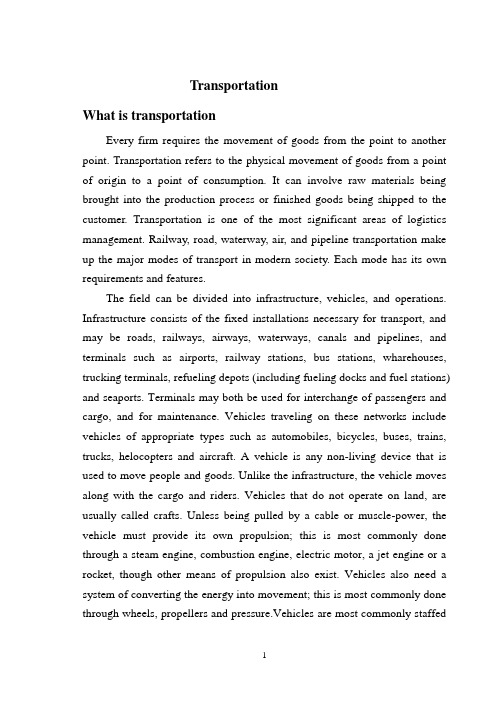
TransportationWhat is transportationEvery firm requires the movement of goods from the point to another point. Transportation refers to the physical movement of goods from a point of origin to a point of consumption. It can involve raw materials being brought into the production process or finished goods being shipped to the customer. Transportation is one of the most significant areas of logistics management. Railway, road, waterway, air, and pipeline transportation make up the major modes of transport in modern society. Each mode has its own requirements and features.The field can be divided into infrastructure, vehicles, and operations. Infrastructure consists of the fixed installations necessary for transport, and may be roads, railways, airways, waterways, canals and pipelines, and terminals such as airports, railway stations, bus stations, wharehouses, trucking terminals, refueling depots (including fueling docks and fuel stations) and seaports. Terminals may both be used for interchange of passengers and cargo, and for maintenance. Vehicles traveling on these networks include vehicles of appropriate types such as automobiles, bicycles, buses, trains, trucks, helocopters and aircraft. A vehicle is any non-living device that is used to move people and goods. Unlike the infrastructure, the vehicle moves along with the cargo and riders. Vehicles that do not operate on land, are usually called crafts. Unless being pulled by a cable or muscle-power, the vehicle must provide its own propulsion; this is most commonly done through a steam engine, combustion engine, electric motor, a jet engine or a rocket, though other means of propulsion also exist. Vehicles also need a system of converting the energy into movement; this is most commonly done through wheels, propellers and pressure.Vehicles are most commonly staffedby a driver. However, some systems, such as people movers and some rapid transits, are fully automated. For passenger transport, the vehicle must have a compartment for the passengers. Simple vehicles, such as automobiles, bicycles or simple aircraft, may have one of the passengers as a driver. Operations deal with the way the vehicles are operated, and the procedures set for this purpose including financing, legalities and policies. In the transport industry, operations and ownership of infrastructure can be either public or private, depending on the country and mode. For public transport and freight transport, operations are done through private enterprise or by governments. The infrastructure and vehicles may be owned and operated by the same company, or they may be operated by different entities. Traditionally, many countries have had a national airline and national railway. Since the 1980s, many of these have been privatized. International shipping remains a highly competitive industry with little regulation,but ports can be public owned.Transportation FacilityThe public sector plays an important role in transport, through the construction, ownership and control of roads, railroads and in most countries also ports. The importance of building up a transport infrastructure that involves considerable cost has made this a widely accepted public task. It should be noted in this context that transport is responsible for a substantial number of jobs in the national economies.The fixed components are usually expensive to build and replace and are long-lived traditionally, there have been few and slow technological changes in these elements. Ports are an exception, in the sense that the ways cargo is handled have changed dramatically over the last two decades, especially with the introduction of containers.The mobile elements involved in the production of transport: trucks,rail-wagons, barges, ships, etc, are relatively short-lived, especially as the wear and tear is considerable. In addition, technical development has historically been fast. This does not only relate to the cargo handling techniques, but also to the equipment itself.The mobile units are generally cheap. Ships may be viewed as an exception, but even the price of a ship is low compared to the price of constructing a port or a railway. Unlike the fixed elements, the mobile components of transport may find alternative employment if demand declines in one market. A ship may be moved from one trade or route to another, while a port cannot be moved.The use of mobile units in the transport sector reduces the possibility of benefit from economies of scale. Roads, rail-tracks and ports set limits to the size of the individual mobile unit, and consequently to the cargo shipped. Capacity could—after a certain point—only be expanded by adding more trucks, ships, etc.It is the features of the fixed and mobile components of transport that have influenced the present institutional arrangements in the industry. The high cost of provision, longevity and scale economies associated with the fixed components created tendencies towards monopoly control, while the ease of entry, flexibility and lack of scale effects tend to stimulate competition in the mobile sector. In principle, the structure of the mobile part of the supply side of the transport industry is characterized by many suppliers working on a basis of free competition. It is perhaps typical that the tendency to deviate from this dictum is found in the liner shipping sector of the industry, which is the least mobile, inter alia, because a regular shipping line depend on heavy investments in the infrastructure.Transportation ModesA mode of transport is a technological solution that used afundamentally different vehicle, infrastructure and operations. The transport of a person or cargo may be by one or more modes, the latter called intermodal transport. Each mode has its advantages and disadvantages, its own requirements and features,and will be chosen for a trip depended on the nature of the purpose, cargo and destination. While there transport in air and on water has their own mode, land transport has several modes.The five transportation modes are rail, road, water, air, and pipeline. The relative importance of each mode can be measured in terms of system mileage, traffic volume, revenue, and the nature of traffic composition. Each mode is discussed with respect to these measures.Railway TransportationThe capacity to efficiently transport large tonnage over long distance is the main reason railroads continue to handle significant inter-city tonnage and revenue. Rail offers cost-effective transport of large quantities of cargos over long distance. It is especially good for cargoes with high volume and low value, such as coal, timber and grain. Railroads operations incur high fixed costs because of expensive equipment, right-of-way, switching yards, and terminals. However, rail experiences relatively low variable operation costs. Over the past years rail usage has declined as road transport has taken over short haul business and water transport has taken bulk commodities freight. Rail transport is one of the most energy efficient modes of land transport. Environmental and safe consideration also favor rail over road transport.However, the major disadvantages of railway are the inherent inflexibility of operation, fixed time schedules and service from terminal to terminal.To provide improved service to major rail users, progressive railroads have concentrated on the development of specialized equipment, such as theenclosed tri-level automobile car, cushioned appliance cars, unit trains, articulated cars, and double-stack containers. Unit trains are an entire train carrying a single product. Typically, the product is a buck commodity such as coal or grain. Unit trains have also been used to support assembly operations for the automobile industry. The unit train is faster and less expensive to operate than traditional trains since it can bypass rail-yards and go direct to the product’s destination. Articulated cars have an extended rail chassis that can haul up to ten containers on a single flexible unit.Road TransportationRoad transport is widely used in inland delivery of goods. This mode tends to be used for higher-value and lower-volume cargo over relatively short distance. It is capable of providing a door to door service. It has not any break in the journey to change from one vehicle to another. So it can be flexible enough to perform “just-in-t ime” delivery. Any work place in the country can be serviced by road.The advantages of road transport are flexibility of both location and time and speed of delivery. To a significant degree the rapid growth of the road carrier industry results from door-to-door operating flexibility and speed of inter-city movement. With the development of road transport, new types of problem, such as a significant growth of fuel consumption, air pollution, traffic congestion and road accidents have emerged.In comparison to railroads, road carriers have relatively small fixed investments in terminal facilities and operate on publicly maintained highways. Although the cost of license fees, user fees, and tolls is considerable, these expenses are directly related to the number of over-the-road units and miles operated. The variable cost per mile for motor carriers is high because a separate power unit and drive are required for each trailer or combination of tandem trailers. Labor requirements are also highbecause of driver safety restrictions and the need for substantial dock labor. W aterway TransportationWaterway transportation includes maritime and river transportation. As the oldest mode of transport, waterway has developed considerably over the last decades. Waterway is utilized for large loads of low-value-per-unit goods. The carriers are specialized for internal river, canal transport, and international deep-sea ships.It is the cheapest method of moving goods world wide. The main advantage of shipping industry lies in moving the vast quantities of cargo in one ship. The main disadvantages of water transport are the limited rang of operation and speed of the ship which is very slowly. Unless the original and destination of the movement are adjacent to a waterway, supplemental haul by rail or truck is required. The capability of water to carry large tonnage at low variable cost places this mode of transport in demand when low freight rates are desired and speed of transit is a secondary consideration.Water transport ranks between rail and road carrier in respect to fixed cost. Although water carriers must develop and operate their own terminals, the right-of-way is developed and maintained by the government and results in moderate fixed costs compared to rail and highway.Air TransportationAir transport has been increased tremendously and plays a more important role in global logistics than ever before. Air transport accounts for the smallest proportion of cargo transportation. Its growth rate in recent years is the highest among the modes of transport. It offers rapid and flexible delivery. The major advantage of air freight is the speed of travel. The longer the distance of the flight, the greater the time saving of the customer. Air transport is primarily used for: Emergency transport of the critical items, Speedy transport of high-value, low-weight products, Speedy transport ofperishable items.One prohibitive aspect of air transport is the high cost. However, this can be traded off for high speed, which allows other elements of logistical design, such as warehousing or inventory, to be reduced or eliminated.The fixed cost of air transport is low compared to rail, water, and pipeline. In fact, air transport ranks second only to road with respect to low fixed cost. Airways and airport are generally developed and maintained with public funds.Pipeline TransportationPipelines are a significant part of the United States transportation system. In 1989, they accounted for over 53 percent of all crude and petroleum ton-mile movements.The basic nature of pipeline is unique in comparison to all other modes of transport. Pipelines operate on a twenty-four-hour basis, seven days per week, and are limited only by commodity changeover and maintenance. Unlike other modes, there is no empty “container” or “vehicle” that must be returned. Pipelines have the highest fixed cost and lowest variable cost among transport modes. Pipeline routes are practically unlimited. An obvious disadvantage is that pipelines are not flexible and are limited with respect to commodity that can be transported: only products in the form of gas, liquid, or slurry can be handled. Pipelines are usually used to transit natural gas, petroleum and coal. Natural gas and crude oil account for the majority of pipeline traffic. Considering the world's dependence on energy products, pipelines will probably become even more important in the future .Pipelines offer the shipper an extremely high level of service dependability at a relatively low cost. Pipelines are able to deliver their product on time because of the following factors: (1)The flows of products within the pipeline are monitored and controlled by computer. (2)Losses anddamages due to pipeline leaks or breaks are extremely rare. (3)Climatic conditions have minimal effects on products, moving in pipelines.(4)Pipelines are not labor - intensive;Therefore, strikes or employee absences have little effect on their operations. The cost and dependability advantages pipelines have over other transport modes have stimulated shipper interest in moving other products by pipeline.Transportation ManagementThe economic factors of transportationTransport economics is influenced by seven factors. While not direct components of transport rate tables, each factor is considered when developing rates. The specific factors are distance, volume, density, stowability, handling, liability, and market. In general, the above sequence reflects the relative importance of each factor. The specific characteristics are discussed below.Distance is a major influence on transportation cost since it directly contributes to variable cost, such as labor, fuel, and maintenance.The second factor is load volume. Like many other logistics activities, transportation scale economies exist for most movements. Transportation cost per unit of weight decreases as load volume increase.The third economic factor is product density, which incorporates weight and space considerations. These are important since transportation cost is usually quoted in terms of dollars per unit of weight, such as amount per ton or amount of per hundredweight (cwt). Once a vehicle is full, it is not possible to increase the amount carried even if the product is light. Since actual and fuel expenses are not influenced by weight, high density products allow relatively fixed transport costs to be spread across additional weight. As a result, these products are assessed lower transport costs per unit of weight.The stowability factor refers to product dimensions and how they affect vehicle(railcar, trailer, or container)space utilization. Odd sizes and shapes, as well as excessive weight or length, do not stow well and typically waste space. Items with standard rectangular shapes are much easier to stow than odd-shaped items.Special handling equipment may be required for loading or unloading trucks, railcars, or ships. Therefore, the manner in which products are physically grouped together(e.g., taped, boxed, or palletized)for transport and storage also affects handling cost.Finally, market factors, such as lane volume and balance, influence transportation cost. A transport lane refers to movements between original and destination points. Since transportation vehicles and drivers must return to their original, either they must find a load to bring back(“back-haul”). When deadhead movements occur, labor, fuel, and maintenance costs must be charged against the original “front-haul” move. Thus, the ideal situation is for “balanced”moves where volume is equal in both directions. However, this is rarely the case because of demand imbalances in manufacturing and consumption locations.Transport DocumentationSeveral documents are required to perform each transport movement. The three primary types are bills of lading, freight bills, and shipping manifests.The bill of lading is the basic document utilized in purchasing transport service. It serves as a receipt and documents commodities and quantities shipped. For this reason, accurate description and count are essential. In case of loss, damage, or delay, the bill of lading is the basis for damage claims. The designated individual or buyer on a bill of lading is the only bona fide recipient of goods. A carrier is responsible for proper delivery according toinstructions contained in the document. In effect, title is transferred with completion of delivery.The bill of lading specifies terms and conditions of carrier liability and documents responsibility for all possible causes of loss or damage expect those defined as acts of God. It is important that terms and conditions be clearly understood so that appropriate actions can be taken in the event of substandard performance. Recent ICC rulings permit bills of lading to be computerized and electronically transmitted between shippers and carriers.In addition to the uniform bill of lading, other commonly used types are order-notified, export, and government. It is important to select the correct bill of lading for a specific shipment.An order notified of negotiable bill of lading is a credit instrument. It provides that delivery not be made unless the original bill of lading is surrendered to the carrier. The usual procedure is for the seller to send the order notified bill of lading to a third party, usually a bank or credit institution. Upon customer payment for the product, the credit institution releases the goods. This facilitates international transport where payment for goods is a major consideration.An export bill of lading permits domestic use of export rates, which are sometimes lower than domestic rates. Export rates may reduce total cost if applied to domestic origin or destination line-haul transport.The freight bill represents a carrier’s method of charging for transportation services. It is developed using information contained in the bill of lading. The freight bill may be prepaid or collect. A prepaid bill means that transport cost must be paid prior to performance, whereas a collect shipment shifts payment responsibility to the consignee. Considerable administration is involved in preparing bills of lading and freight bills. There has been considerable effect to automate freight bills and bills of lading through EDItransaction. Some firms now elect to pay their freight bills at the time the bill of lading is created, thereby combining the tow documents. Such arrangements are based on relative financial benefits of reduced paperwork costs. Many attempts are also under way to produce all transport documents simultaneously. This has become more practical with the use of computer.The shipping manifest lists individual stops or consignees when multiple shipments are placed on a single vehicle. Each shipment requires a bill of lading. The manifest lists the stop, bill of lading, weight, and case count for each shipment. The objective of the manifest is to provide a single document that defines the contents of the total load without requiring a review of individual bills of lading. For single-stop shipments, the manifest is the same as the bill of lading.运输一、什么是运输每一个公司都要求货物从一个点移到另一个点。
How to write an effective sales letter
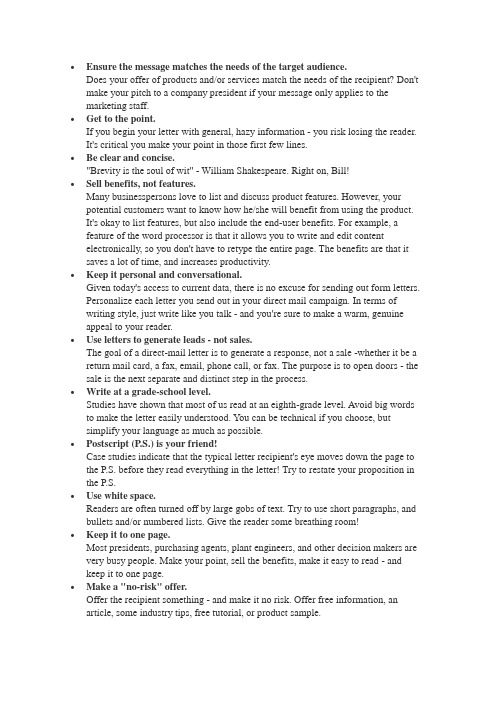
∙Ensure the message matches the needs of the target audience.Does your offer of products and/or services match the needs of the recipient? Don't make your pitch to a company president if your message only applies to themarketing staff.∙Get to the point.If you begin your letter with general, hazy information - you risk losing the reader.It's critical you make your point in those first few lines.∙Be clear and concise."Brevity is the soul of wit" - William Shakespeare. Right on, Bill!∙Sell benefits, not features.Many businesspersons love to list and discuss product features. However, your potential customers want to know how he/she will benefit from using the product.It's okay to list features, but also include the end-user benefits. For example, afeature of the word processor is that it allows you to write and edit contentelectronically, so you don't have to retype the entire page. The benefits are that it saves a lot of time, and increases productivity.∙Keep it personal and conversational.Given today's access to current data, there is no excuse for sending out form letters.Personalize each letter you send out in your direct mail campaign. In terms ofwriting style, just write like you talk - and you're sure to make a warm, genuine appeal to your reader.∙Use letters to generate leads - not sales.The goal of a direct-mail letter is to generate a response, not a sale -whether it be a return mail card, a fax, email, phone call, or fax. The purpose is to open doors - the sale is the next separate and distinct step in the process.∙Write at a grade-school level.Studies have shown that most of us read at an eighth-grade level. Avoid big words to make the letter easily understood. You can be technical if you choose, butsimplify your language as much as possible.∙Postscript (P.S.) is your friend!Case studies indicate that the typical letter recipient's eye moves down the page to the P.S. before they read everything in the letter! Try to restate your proposition in the P.S.∙Use white space.Readers are often turned off by large gobs of text. Try to use short paragraphs, and bullets and/or numbered lists. Give the reader some breathing room!∙Keep it to one page.Most presidents, purchasing agents, plant engineers, and other decision makers are very busy people. Make your point, sell the benefits, make it easy to read - and keep it to one page.∙Make a "no-risk" offer.Offer the recipient something - and make it no risk. Offer free information, anarticle, some industry tips, free tutorial, or product sample.∙Create a deadline.Whether there is a real deadline or one you create, make one. Usually, a deadline increases the rate of responses because of the limited amount of time to act.∙Call to action!Ask and ye shall receive . . . Why not ask for the order? "Call our toll-free number, 800-555-SALES, for a free consultation".∙Use postage reply mail.Include a business reply card for better response. Make sure it has pre-paid postage.Don't lose an inquiry for the cost of a single stamp.∙Include a guarantee.If you can offer a guarantee - be it your follow-up, delivery, customer service, orpricing - do it. By offering a guarantee, you offer integrity and credibility to your products/services.∙Include testimonials.Nothing speaks louder for your product or services than a satisfied end user.However, if you use names and companies, make sure you get a signedauthorization from them.About the Author Brad Dunn is a freelance writer and marketing consultant. He has helped numerous organizations promote themselves and communicate more effectively. After 15 years as a staff writer, he started Vantage Consulting.1.Subject: Acme2.Hi [prospect name]! Hope you are well.3.Acme is the industry leader...[a paragraph about how wonderful Acme is.]4.Acme has the following products and services... [a bulleted "spray and pray"list.]5.Acme has served the following customers... [some big companies.]6.I would like to set up a 20 minute phone call to discuss how we can help you.7.If you need any further information, don't hesitate to call me at [number] orbrowse our website [website.]8.Sincerely, [sender's name and contact info]To understand why this type of letter doesn't get a response, let's look at it from the perspective of the potential customer:1.The subject line means nothing to me, so I probably won't open it.2.I don't know you, so the greeting rings false and the concern for my health isbogus.3.Why should I care about your company?4.What does any of this have to do with me?5.I'm an SMB; if you work with large enterprises then you're probably going totreat me like small potatoes.6.Are you effing kidding me? Like I have 20 minutes in my crazy schedule to hearsome dumb-*ss sales pitch.7.Apparently, you think I'm so stupid that I can't find your phone number andwebsite under your signature. Also, you apparently live in some cloud cuckoo land where I'm desperate to have a conversation with somebody who hasalready wasted three minutes of my time with this confusing e-mail.8. A final lie, since there's nothing sincere about anything in this e-mail.It's amazing that salespeople get any response at all from this kind of dreadful communique. It's practically begging to be deleted.A Method that Actually WorksHere's the structure for a sales e-mail that's more likely to get a response:1.Subject: [something relevant to the prospect]2.Dear [Mr.|Ms. prospect's last name]:3.I'm contacting you because I may be able to [potential benefit to the prospect.]panies like yours ([list]) hire us to do [something quantifiable that leads tothat potential benefit.]5.Reply to this e-mail and I'll e-mail you some details so that you can quicklyevaluate whether it's worth your time to pursue this.6.[sender's name and contact info]Here's why this structure works.1.The subject line engages the recipient to open the e-mail. Examples of"something relevant" would be a mutual contact, a recent change in theprospect's business, a factoid about a prospect's competitor, etc.2.While many industries and companies are informal, when you're contactingsomebody for the first time, it's best to err on the side of formality. Nobody is ever insulted by formality.3.People always appreciate it when you get to the point quickly. From theprospect's perspective the "point" is "what's in it for me." So tell them.4.This is your sales message, but stated from the customer's perspective. Thecustomers in the list should be of similar size and shape to the prospect. If you don't have this list, just use "Our customers hire us to."5.It's unrealistic to expect an initial e-mail to convince a prospect to commit timeto meeting to you. Instead, you make the "next step" something trivial thatindicates the prospect's receptiveness.6.The prospect is smart enough to figure out how to call you or access yourwebsite if required.Here's an ExampleSubject: Inventory Cost OverrunsDear Mr. Jones:I'm contacting you because I might be able to help you reduce your inventorycosts.Our customers hire us to restructure their supply chain to ensure just-in-time component delivery. This typically reduces their inventory storage expense by 40 to 50 percent.Reply to this e-mail and I'll e-mail you some details so you can quickly evaluate whether it would be worth your time to look into this.How to Follow Up to an Unanswered EmailMake It EasyThe optimal way to follow up to an unanswered email is by replying to the first one you sent. This practice allows you to:1.Keep the followup short2.Make the initial context easy for the reader to find3.Emphasize that they have not responded to youBy initially following up on a separate thread, you’re putting an onus on the reader.Often they didn’t read or forgot the initial email. As a result, when they receive your follow-up, they have to dig through their inbox to find the original for context.This is work. Again, the easier you make things, the more likely you’ll achieve an optimal outcome.My follow up email primarily serves to reference the original. Again, this keeps it short and reminds the reader that I have not heard from them. Here is an example script I use all the time:Hi Nucky,I just wanted to circle back on my email below re: getting you a comments widgetfor your site. Are you free for a quick call on Monday or Tuesday?the addition of our widget.Schedule ItThe best way to make sure you follow up, is to schedule it during or immediately after you send an email. There’s a few tools that you can use to do this that are far superior than your calendar. and Boomerang are my favorite. allows you to create reminders by specifying the time interval you’d like to be reminded to follow up within the BCC field. If I entered OneWeek@, I’d receive a reminder a week later to follow up on that email. Boomerang has similar capabilities within the gmail web client.Time IntervalThe time interval between the initial email and the follow up really depends upon where you are in the lifecycle of a relationship or deal. For an initial cold email, following up within 4-7 days is ideal. I don’t like to wait any longer than a week.However, if I’m a bit deeper in the deal funnel, I’ll likely space out follow up emails so I don’t seem too pushy (I often have a soft sale). It really comes down to a feel thing.Though this post may seem targeted at business development and salesprofessionals, following up effectively is something that can dramatically improve anyone’s lives. Here’s a few situations where following up might help you achieve what you’re after:∙You asked someone for help∙The job application process∙Reaching out to an organization for more information∙ A pending invitation to somethingOne thing business development has taught me is that you never get anything you don’t ask for. What few realize is sometimes you have to ask twice : )。
Use case 案例
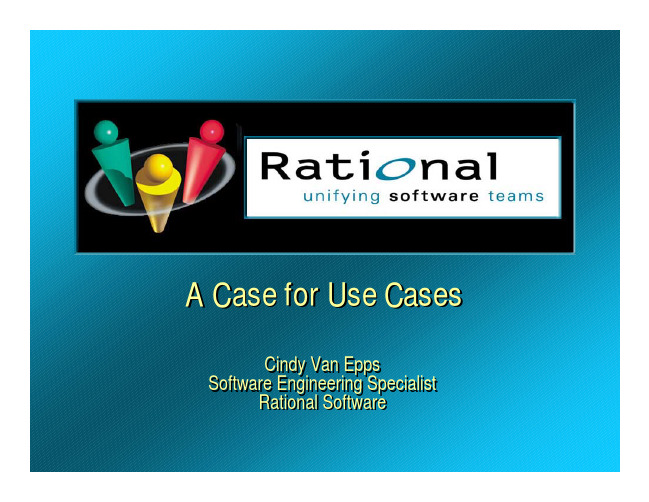
Design:
Design to Implement the Use Cases
Test:
Test that the Use Cases are Fulfilled
Two Simple Core Constructs
Actors Use Cases
An Actor
Bank Customer
An Automated Teller Machine (ATM)
Features of an Example System
Space Shuttle Cockpit Avionics Upgrade M Provide features comparable to existing system M Existing system allows Flight Controllers (ground) and Crew Members to monitor and control avionics of the vehicle and payloads M New system needs to provide better root cause analysis of failures M New system needs to provide faster and more concise summary of information M New system will be embedded in new hardware which is yet to be designed/procured
Glossary Actors Use Cases
...
Supplementary Specification Use-Case Specifications
consumers ease of use
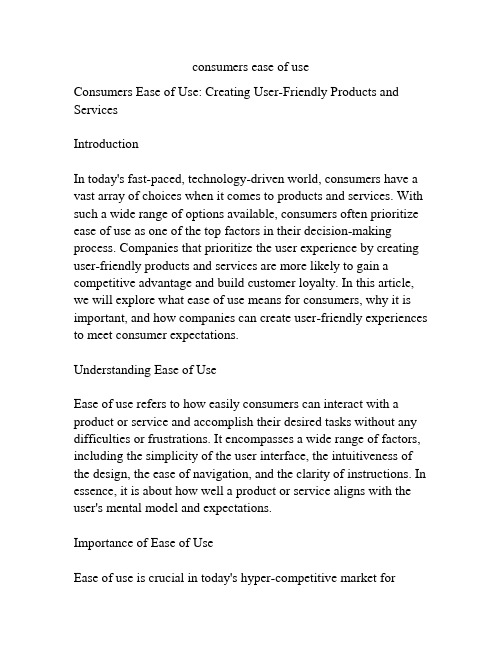
consumers ease of useConsumers Ease of Use: Creating User-Friendly Products and ServicesIntroductionIn today's fast-paced, technology-driven world, consumers have a vast array of choices when it comes to products and services. With such a wide range of options available, consumers often prioritize ease of use as one of the top factors in their decision-making process. Companies that prioritize the user experience by creating user-friendly products and services are more likely to gain a competitive advantage and build customer loyalty. In this article, we will explore what ease of use means for consumers, why it is important, and how companies can create user-friendly experiences to meet consumer expectations.Understanding Ease of UseEase of use refers to how easily consumers can interact with a product or service and accomplish their desired tasks without any difficulties or frustrations. It encompasses a wide range of factors, including the simplicity of the user interface, the intuitiveness of the design, the ease of navigation, and the clarity of instructions. In essence, it is about how well a product or service aligns with the user's mental model and expectations.Importance of Ease of UseEase of use is crucial in today's hyper-competitive market forseveral reasons. First and foremost, it enhances the user experience, making it more enjoyable and efficient for consumers to interact with a product or service. This positive experience can lead to increased customer satisfaction, repeat purchases, and positive word-of-mouth recommendations.Secondly, ease of use can also reduce user frustrations and errors. Complex or poorly designed products and services can often be overwhelming and confusing, leading to user dissatisfaction and even abandonment. By simplifying and streamlining the user interface, companies can minimize the chances of user errors and frustration, which in turn reduces the costs associated with customer support and product returns.Furthermore, ease of use is particularly important in attracting and retaining new users. Consumers today have limited time and attention span, and they are more likely to choose products and services that can be easily understood and quickly adopted. In a market saturated with choices, businesses that offer user-friendly experiences differentiate themselves and stand out from the competition.Creating User-Friendly ExperiencesTo create user-friendly experiences, companies need to prioritize usability in their product and service design. Here are some key strategies that businesses can employ:1. User-Centered Design: Adopting a user-centered design approach is essential to understanding the needs, preferences, andbehaviors of the target audience. Conducting user research, usability testing, and gathering feedback from users throughout the design process ensures that the end product meets their expectations and aligns with their mental models.2. Simplify and Streamline: One of the most effective ways to improve ease of use is to simplify and streamline the user interface. Eliminate unnecessary steps and features that may confuse or overwhelm users. Clear and concise instructions, visual cues, and intuitive navigation can significantly enhance usability.3. Consistency: Maintaining consistency in the design and functionality of a product or service is essential for ease of use. Users should be able to apply their knowledge from one part of the product to another, reducing the learning curve and improving efficiency. Consistency also helps create a sense of familiarity, which can make users feel more at ease.4. Accessibility: Ensuring that the product or service is accessible to all users, including those with disabilities, is critical for ease of use. Designing for accessibility means considering factors such as color contrast, font size, and screen reader compatibility. Making accommodations for different abilities enhances the user experience for a wider audience.5. Iterative Improvement: Ease of use is not a one-time effort but an ongoing process. Companies should continuously monitor and gather feedback from users, analyzing their behavior and identifying areas for improvement. Regular updates and adjustments based on user input are essential to maintaining a user-friendly experience.ConclusionIn conclusion, consumers prioritize ease of use when it comes to choosing products and services. Creating user-friendly experiences is crucial for companies to remain competitive in today's market. By understanding what ease of use means to consumers and implementing strategies such as user-centered design, simplification, consistency, accessibility, and iterative improvement, businesses can create products and services that meet user expectations, enhance user satisfaction, and build long-term customer loyalty.。
降低客服业务流程错误的措施

降低客服业务流程错误的措施英文回答:Measures to Reduce Errors in Customer Service Business Processes.1. Establish clear and concise processes.Well-defined processes provide a framework for customer service representatives to follow, reducing the likelihood of errors. These processes should be documented and easily accessible to all staff.2. Train staff thoroughly.Proper training ensures that customer service representatives have the knowledge and skills to handle customer interactions effectively. Representatives should be trained on the company's products, services, and policies, as well as communication and problem-solvingtechniques.3. Use technology to automate tasks.Automation can reduce the risk of human error by eliminating manual processes. For example, automatedrouting systems can direct incoming calls to the most appropriate representative based on the customer's inquiry.4. Implement quality control measures.Monitoring and evaluating the performance of customer service processes is crucial for identifying and addressing areas for improvement. This can involve reviewing call recordings, customer feedback, and other metrics.5. Encourage a culture of continuous improvement.Foster a work environment where customer service representatives are encouraged to identify and suggest ways to improve processes. This can be achieved through regular feedback sessions, brainstorming workshops, and otherinitiatives.6. Empower customer service representatives.Empowering customer service representatives with the authority to make decisions can reduce the risk of errors. This allows representatives to resolve customer issues quickly and effectively, without having to consult with supervisors.7. Use knowledge management tools.Centralized knowledge management tools provide customer service representatives with easy access to up-to-date information and resources. This reduces the likelihood of errors due to outdated or inaccurate information.8. Leverage artificial intelligence (AI)。
电子商务 翻译

电子商务翻译Electronic commerce, also known as e-commerce, refers to the buying and selling of goods and services over the internet. It has become an increasingly popular way for businesses to reach and engage with customers, as well as for consumers to access a wide range of products from the comfort of their own homes.One of the main advantages of e-commerce is the convenience it offers to both businesses and consumers. With e-commerce, businesses can set up online stores that are accessible 24/7, allowing customers to browse and purchase products at any time. This eliminates the need for physical stores and reduces operating costs for businesses. On the consumer side, e-commerce allows them to shop from anywhere and at any time, without the need to travel to a physical store.Another benefit of e-commerce is its global reach. With the internet, businesses can expand their customer base beyond their local markets and reach customers from all over the world. This opens up new opportunities for businesses to grow and diversify their revenue streams. For consumers, e-commerce gives them access to a wider selection of products that may not be available in their local area.E-commerce also offers a personalized and tailored shopping experience. With the help of data analytics and artificial intelligence, businesses can gather information about their customers' preferences and shopping habits, and then use this information to personalize product recommendations and discounts. This creates a more engaging and enjoyable shopping experiencefor customers, leading to increased customer loyalty and retention.However, there are also challenges and risks associated with e-commerce. One of the main challenges is the issue of trust and security. Customers need to trust that their personal and payment information will be protected when making online purchases. Businesses need to invest in secure payment systems and data encryption to ensure the safety of their customers' information. Additionally, there is always the risk of online fraud and scams, which businesses and consumers need to be aware of and take precautions against.In conclusion, e-commerce has revolutionized the way businesses operate and how consumers shop. It offers convenience, global reach, and personalized experiences for both businesses and consumers. While there are challenges and risks involved, the benefits of e-commerce far outweigh them, making it an essential part of the modern business landscape.。
UseCase
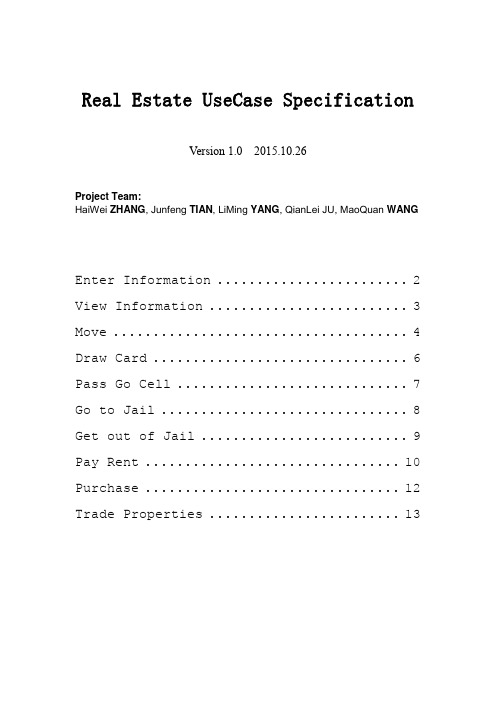
goToJail1
Priority
2
Story Points
2
Participate
Players, GoTo JailCell, Jail Cell
Precondition
1.the player’s turn.
2.The player has rolled the dice andplayer lands on aGo To Jailcell.
Acceptance Test
communityChest1
Priority
2
Story Points
2
Participate
Players,Community ChestorChance Cell
Precondition
1.the player’s turn.
2.The player has rolled the dice andplayer lands on a card cell.
Real Estate UseCase Specification
Version1.02015.10.26
Project Team:
HaiWeiZHANG, JunfengTIAN, LiMingYANG, QianLei JU, MaoQuanWANG
Enter Information2
View Information3
Post-condition
Main steps
1.If the card is a Jail card, the player goes toJail without getting paid when passing the Go cell.
customer use cases and feedback -回复
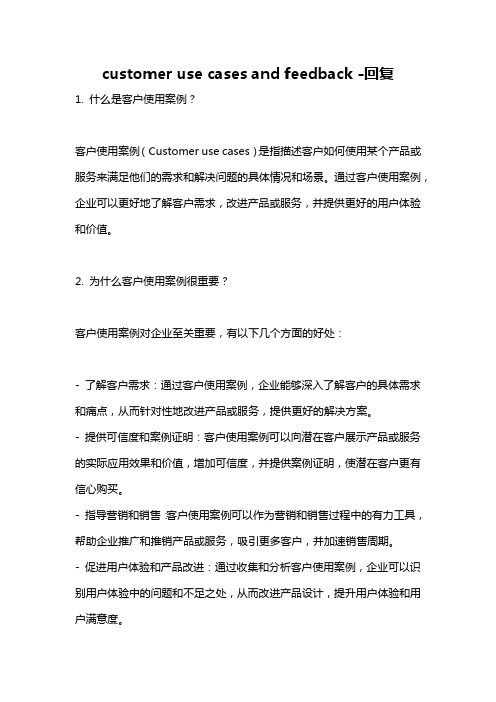
customer use cases and feedback -回复1. 什么是客户使用案例?客户使用案例(Customer use cases)是指描述客户如何使用某个产品或服务来满足他们的需求和解决问题的具体情况和场景。
通过客户使用案例,企业可以更好地了解客户需求,改进产品或服务,并提供更好的用户体验和价值。
2. 为什么客户使用案例很重要?客户使用案例对企业至关重要,有以下几个方面的好处:- 了解客户需求:通过客户使用案例,企业能够深入了解客户的具体需求和痛点,从而针对性地改进产品或服务,提供更好的解决方案。
- 提供可信度和案例证明:客户使用案例可以向潜在客户展示产品或服务的实际应用效果和价值,增加可信度,并提供案例证明,使潜在客户更有信心购买。
- 指导营销和销售:客户使用案例可以作为营销和销售过程中的有力工具,帮助企业推广和推销产品或服务,吸引更多客户,并加速销售周期。
- 促进用户体验和产品改进:通过收集和分析客户使用案例,企业可以识别用户体验中的问题和不足之处,从而改进产品设计,提升用户体验和用户满意度。
3. 如何编写客户使用案例?编写客户使用案例需要以下几个步骤:- 选择适当的客户:选择与目标用户类似的客户,重点关注那些能够有效展示产品或服务价值和优势的客户。
- 开展访谈和调研:与客户进行深入访谈和调研,了解他们使用产品或服务的具体情况、需求和体验,探询他们遇到的问题和解决方法。
- 描述客户背景和挑战:概述客户的背景信息,包括行业、规模、关键问题等,然后描绘客户所面临的具体挑战和需求。
- 描述解决方案和结果:详细描述企业的产品或服务是如何解决客户的挑战和需求,以及实际实施的过程和结果。
重点突出产品或服务带来的价值和效果。
- 引用客户言论和数据:在客户使用案例中引用客户的言论和数据,以便增加信任度和说服力,并向读者展示客户的满意度和实际成果。
- 以客户为中心:在编写客户使用案例时,始终要以客户为中心,突出他们的需求、挑战和成功,强调产品或服务的用户价值和用户体验。
英语催单技巧 英文
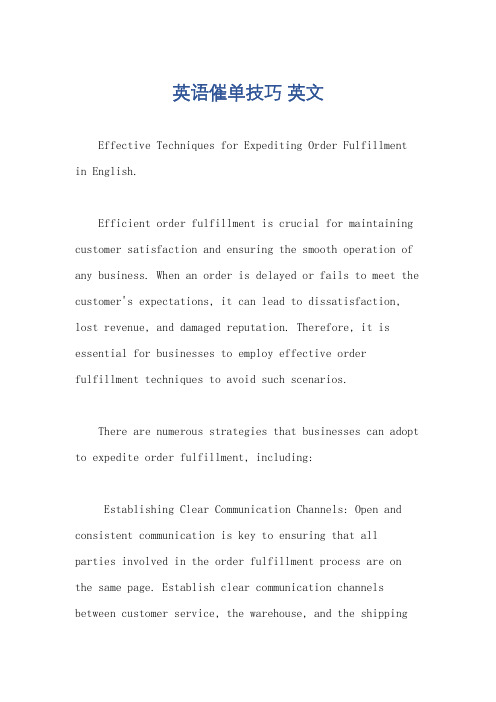
英语催单技巧英文Effective Techniques for Expediting Order Fulfillment in English.Efficient order fulfillment is crucial for maintaining customer satisfaction and ensuring the smooth operation of any business. When an order is delayed or fails to meet the customer's expectations, it can lead to dissatisfaction, lost revenue, and damaged reputation. Therefore, it is essential for businesses to employ effective order fulfillment techniques to avoid such scenarios.There are numerous strategies that businesses can adopt to expedite order fulfillment, including:Establishing Clear Communication Channels: Open and consistent communication is key to ensuring that allparties involved in the order fulfillment process are on the same page. Establish clear communication channels between customer service, the warehouse, and the shippingdepartment to facilitate the timely exchange of information and minimize the risk of errors.Investing in Inventory Management Software: Manual inventory management can be error-prone and inefficient, leading to delays in order fulfillment. Invest in inventory management software that provides real-time inventory visibility, automates inventory replenishment, and optimizes picking and packing processes. This will help businesses maintain accurate inventory levels and reduce the likelihood of stockouts.Optimizing Warehouse Operations: The warehouse plays a crucial role in ensuring efficient order fulfillment. Implement proper warehouse management practices, such as optimizing warehouse layout, establishing efficient picking and packing processes, and utilizing technology like barcode scanners and RFID tags to streamline operations. This will reduce order fulfillment times and improve accuracy.Partnering with Reliable Shipping Carriers: Chooseshipping carriers that offer reliable and timely delivery services. Establish clear shipping guidelines and track shipments proactively to ensure they are on schedule. Consider offering expedited shipping options for customers who require faster delivery times.Implementing Order Tracking Systems: Provide customers with real-time order tracking information to keep them informed about the status of their orders. This transparency builds trust and reduces customer inquiries, freeing up customer service resources to focus on other tasks.Automating Order Fulfillment Processes: Utilize automation tools to streamline order fulfillment processes. This includes automating order entry, inventory management, shipping label generation, and other repetitive tasks. Automation can significantly reduce errors, save time, and improve efficiency.Providing Excellent Customer Service: Excellent customer service is paramount to managing and resolving anyorder fulfillment issues promptly. Train customer service representatives to be knowledgeable, responsive, and empowered to resolve customer inquiries and complaints effectively.Conducting Regular Performance Reviews: Regularly assess the performance of your order fulfillment processes to identify areas for improvement. Track key metrics such as order fulfillment time, accuracy rate, and customer satisfaction levels. Use this data to make data-driven decisions and optimize your order fulfillment strategy.Best Practices for Expediting Order Fulfillment:In addition to implementing the aforementioned techniques, consider the following best practices to further enhance your order fulfillment process:Use dedicated order fulfillment software: This specialized software streamlines the entire order fulfillment process, from order entry to shipping.Establish clear order fulfillment policies: Communicate your order fulfillment policies, including shipping methods, delivery times, and return procedures, clearly to customers.Provide multiple shipping options: Offer a range of shipping options to cater to different customer needs and budgets.Offer order consolidation: Allow customers to combine multiple orders into a single shipment to save on shipping costs and reduce delivery times.Consider dropshipping: Partner with suppliers who offer dropshipping services to eliminate the need for inventory storage and expedite order fulfillment.Outsource order fulfillment: If your business lacks the resources or expertise to handle order fulfillment in-house, consider outsourcing to a third-party logistics provider.By implementing these effective techniques and adhering to best practices, businesses can significantly expedite order fulfillment, improve customer satisfaction, and gain a competitive advantage in the marketplace.。
快递的盘点流程
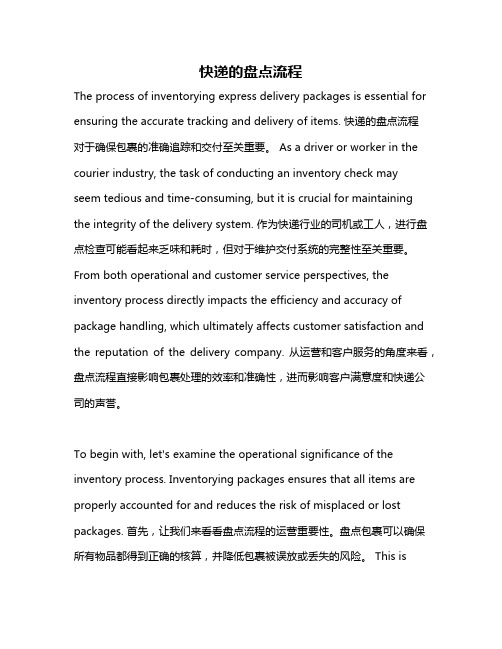
快递的盘点流程The process of inventorying express delivery packages is essential for ensuring the accurate tracking and delivery of items. 快递的盘点流程对于确保包裹的准确追踪和交付至关重要。
As a driver or worker in the courier industry, the task of conducting an inventory check may seem tedious and time-consuming, but it is crucial for maintaining the integrity of the delivery system. 作为快递行业的司机或工人,进行盘点检查可能看起来乏味和耗时,但对于维护交付系统的完整性至关重要。
From both operational and customer service perspectives, the inventory process directly impacts the efficiency and accuracy of package handling, which ultimately affects customer satisfaction and the reputation of the delivery company. 从运营和客户服务的角度来看,盘点流程直接影响包裹处理的效率和准确性,进而影响客户满意度和快递公司的声誉。
To begin with, let's examine the operational significance of the inventory process. Inventorying packages ensures that all items are properly accounted for and reduces the risk of misplaced or lost packages. 首先,让我们来看看盘点流程的运营重要性。
关于扫码点餐的作文英语
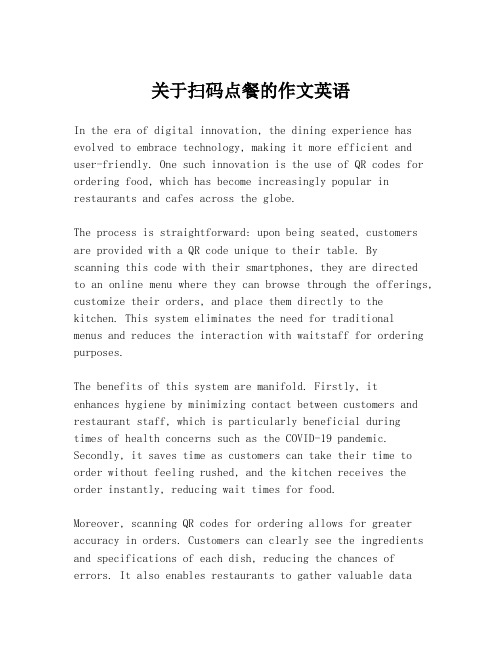
关于扫码点餐的作文英语In the era of digital innovation, the dining experience has evolved to embrace technology, making it more efficient and user-friendly. One such innovation is the use of QR codes for ordering food, which has become increasingly popular in restaurants and cafes across the globe.The process is straightforward: upon being seated, customers are provided with a QR code unique to their table. Byscanning this code with their smartphones, they are directedto an online menu where they can browse through the offerings, customize their orders, and place them directly to the kitchen. This system eliminates the need for traditional menus and reduces the interaction with waitstaff for ordering purposes.The benefits of this system are manifold. Firstly, it enhances hygiene by minimizing contact between customers and restaurant staff, which is particularly beneficial duringtimes of health concerns such as the COVID-19 pandemic. Secondly, it saves time as customers can take their time to order without feeling rushed, and the kitchen receives the order instantly, reducing wait times for food.Moreover, scanning QR codes for ordering allows for greater accuracy in orders. Customers can clearly see the ingredients and specifications of each dish, reducing the chances of errors. It also enables restaurants to gather valuable dataon customer preferences, which can be used to improve menu offerings and customer satisfaction.However, this method is not without its drawbacks. For instance, it can be challenging for those who are not tech-savvy or do not own a smartphone. Additionally, the reliance on technology can sometimes lead to system failures or connectivity issues, which can disrupt the ordering process.In conclusion, the use of QR codes for ordering food represents a significant leap forward in the dining industry. It offers a convenient, efficient, and often more enjoyable way for customers to engage with the dining experience. As technology continues to advance, it is likely that such systems will become even more sophisticated, further enhancing the way we dine out.。
订单流程编排组件
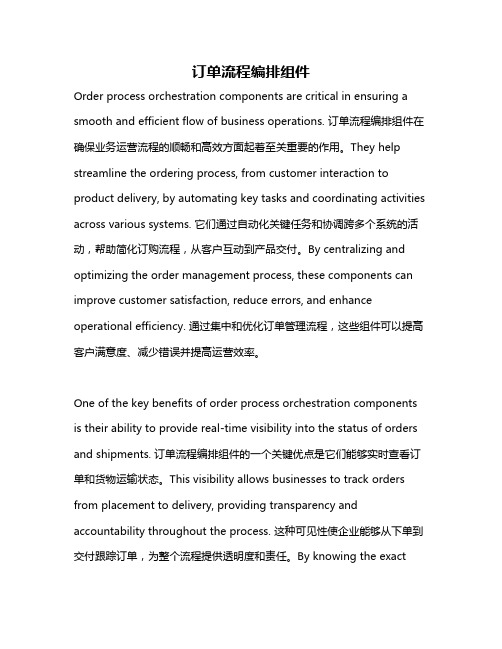
订单流程编排组件Order process orchestration components are critical in ensuring a smooth and efficient flow of business operations. 订单流程编排组件在确保业务运营流程的顺畅和高效方面起着至关重要的作用。
They help streamline the ordering process, from customer interaction to product delivery, by automating key tasks and coordinating activities across various systems. 它们通过自动化关键任务和协调跨多个系统的活动,帮助简化订购流程,从客户互动到产品交付。
By centralizing and optimizing the order management process, these components can improve customer satisfaction, reduce errors, and enhance operational efficiency. 通过集中和优化订单管理流程,这些组件可以提高客户满意度、减少错误并提高运营效率。
One of the key benefits of order process orchestration components is their ability to provide real-time visibility into the status of orders and shipments. 订单流程编排组件的一个关键优点是它们能够实时查看订单和货物运输状态。
This visibility allows businesses to track orders from placement to delivery, providing transparency and accountability throughout the process. 这种可见性使企业能够从下单到交付跟踪订单,为整个流程提供透明度和责任。
英语作文对公司的建议
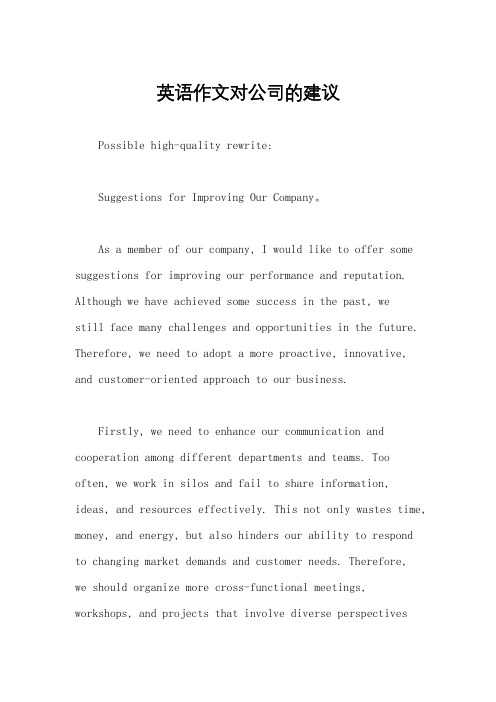
英语作文对公司的建议Possible high-quality rewrite:Suggestions for Improving Our Company。
As a member of our company, I would like to offer some suggestions for improving our performance and reputation. Although we have achieved some success in the past, westill face many challenges and opportunities in the future. Therefore, we need to adopt a more proactive, innovative, and customer-oriented approach to our business.Firstly, we need to enhance our communication and cooperation among different departments and teams. Too often, we work in silos and fail to share information, ideas, and resources effectively. This not only wastes time, money, and energy, but also hinders our ability to respondto changing market demands and customer needs. Therefore,we should organize more cross-functional meetings, workshops, and projects that involve diverse perspectivesand skills. We should also encourage more feedback, brainstorming, and problem-solving sessions that foster a culture of continuous learning and improvement.Secondly, we need to invest more in our employees' development and satisfaction. They are our most valuable assets and drivers of our success. However, many of them feel underappreciated, overworked, and stagnant in their careers. This not only lowers their morale and motivation, but also reduces their productivity and creativity. Therefore, we should offer more training, mentoring, coaching, and recognition programs that help them acquire new skills, knowledge, and experiences. We should also provide more flexible, diverse, and meaningful work arrangements that match their preferences and aspirations.Thirdly, we need to innovate more in our products, services, and processes. We cannot rely on our past achievements or current offerings to sustain our growth and competitiveness. We need to anticipate and adapt to the changing trends, technologies, and customer preferences in our industry. Therefore, we should allocate more resources,time, and talent to research and development, testing and prototyping, and market analysis and feedback. We should also collaborate more with external partners, such as startups, universities, and customers, that bring fresh perspectives and expertise to our innovation efforts.Fourthly, we need to improve our customer experienceand satisfaction. They are the ultimate judges of our value and relevance. However, many of them complain about our slow, unresponsive, and impersonal service, our poorquality and reliability, and our lack of empathy and understanding. This not only damages our reputation and loyalty, but also reduces our revenue and market share. Therefore, we should listen more to our customers' feedback, complaints, and suggestions, and act on them promptly and effectively. We should also personalize, simplify, and enhance our interactions with them, through digital channels, social media, and face-to-face encounters.In conclusion, our company has great potential to become a leader in our industry, but we need to overcome some internal and external obstacles and seize someemerging opportunities. By adopting a more collaborative, innovative, and customer-centric approach, we can enhance our communication, employee development, innovation, and customer experience, and achieve sustainable growth and success.。
sfdc case 例
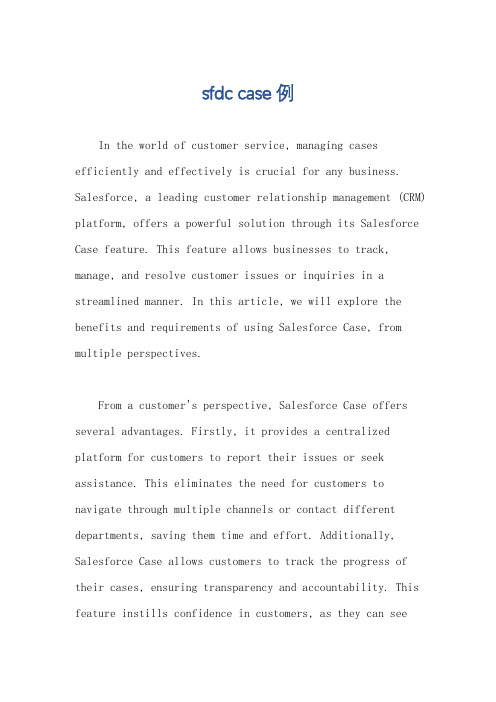
sfdc case 例In the world of customer service, managing cases efficiently and effectively is crucial for any business. Salesforce, a leading customer relationship management (CRM) platform, offers a powerful solution through its Salesforce Case feature. This feature allows businesses to track, manage, and resolve customer issues or inquiries in a streamlined manner. In this article, we will explore the benefits and requirements of using Salesforce Case, from multiple perspectives.From a customer's perspective, Salesforce Case offers several advantages. Firstly, it provides a centralized platform for customers to report their issues or seek assistance. This eliminates the need for customers to navigate through multiple channels or contact different departments, saving them time and effort. Additionally, Salesforce Case allows customers to track the progress of their cases, ensuring transparency and accountability. This feature instills confidence in customers, as they can seethat their concerns are being addressed promptly and efficiently.From a business's perspective, Salesforce Case is a valuable tool for managing customer support operations. By consolidating all customer cases in one place, businesses can gain a holistic view of their customers' needs and pain points. This enables them to identify patterns and trends, leading to more informed decision-making and proactive problem-solving. Moreover, Salesforce Case offers automation capabilities, such as case assignment rules and escalation processes, which streamline workflows and ensure that cases are routed to the right teams or individuals. This automation reduces manual efforts and improves response times, ultimately enhancing the overall customer experience.Salesforce Case also benefits customer support agents by providing them with a structured framework for managing cases. The platform offers various features, such as case queues, case assignment rules, and case comments, which help agents prioritize and collaborate on resolving casesefficiently. Moreover, Salesforce Case allows agents to access a comprehensive view of customer information, including past interactions and case history. This holistic view empowers agents to provide personalized and contextual support, leading to higher customer satisfaction and loyalty.Furthermore, Salesforce Case integrates seamlessly with other Salesforce features, such as knowledge base and service contracts. This integration enables agents to leverage existing knowledge articles or documentation to resolve cases more effectively. By having access to a centralized knowledge base, agents can quickly find relevant information and provide accurate solutions to customers. Additionally, Salesforce Case allows businesses to set up service level agreements (SLAs) and monitor their adherence. This ensures that cases are handled within predefined timelines, enhancing customer satisfaction and maintaining service excellence.In conclusion, Salesforce Case is a powerful feature within the Salesforce CRM platform that offers numerousbenefits from multiple perspectives. From a customer's standpoint, it provides a centralized platform to report issues and track their progress, ensuring transparency and confidence. For businesses, Salesforce Case streamlines customer support operations, enabling them to gain insights, automate workflows, and improve overall customer experience. It empowers agents with a structured framework, access to customer information, and integration with knowledge base and service contracts. By leveraging Salesforce Case, businesses can effectively manage cases, resolve customer issues promptly, and foster long-term customer relationships.。
仓储管理制度英语
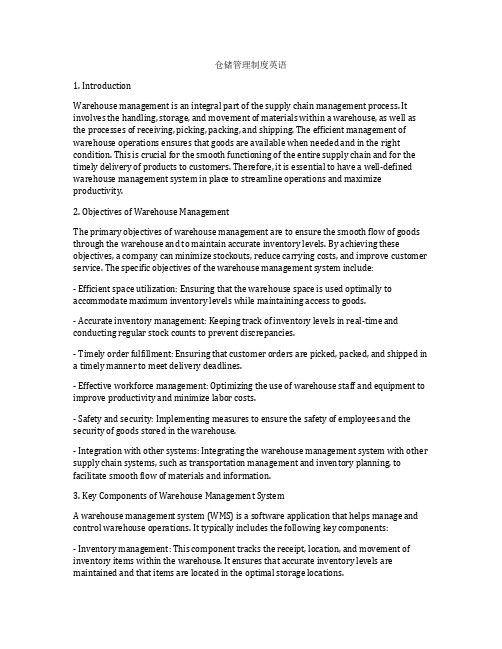
仓储管理制度英语1. IntroductionWarehouse management is an integral part of the supply chain management process. It involves the handling, storage, and movement of materials within a warehouse, as well as the processes of receiving, picking, packing, and shipping. The efficient management of warehouse operations ensures that goods are available when needed and in the right condition. This is crucial for the smooth functioning of the entire supply chain and for the timely delivery of products to customers. Therefore, it is essential to have a well-defined warehouse management system in place to streamline operations and maximize productivity.2. Objectives of Warehouse ManagementThe primary objectives of warehouse management are to ensure the smooth flow of goods through the warehouse and to maintain accurate inventory levels. By achieving these objectives, a company can minimize stockouts, reduce carrying costs, and improve customer service. The specific objectives of the warehouse management system include:- Efficient space utilization: Ensuring that the warehouse space is used optimally to accommodate maximum inventory levels while maintaining access to goods.- Accurate inventory management: Keeping track of inventory levels in real-time and conducting regular stock counts to prevent discrepancies.- Timely order fulfillment: Ensuring that customer orders are picked, packed, and shipped in a timely manner to meet delivery deadlines.- Effective workforce management: Optimizing the use of warehouse staff and equipment to improve productivity and minimize labor costs.- Safety and security: Implementing measures to ensure the safety of employees and the security of goods stored in the warehouse.- Integration with other systems: Integrating the warehouse management system with other supply chain systems, such as transportation management and inventory planning, to facilitate smooth flow of materials and information.3. Key Components of Warehouse Management SystemA warehouse management system (WMS) is a software application that helps manage and control warehouse operations. It typically includes the following key components:- Inventory management: This component tracks the receipt, location, and movement of inventory items within the warehouse. It ensures that accurate inventory levels are maintained and that items are located in the optimal storage locations.- Order management: This component manages the flow of customer orders through the warehouse, from order entry to picking, packing, and shipping. It ensures that orders are processed accurately and on time.- Labor management: This component helps optimize the use of warehouse staff by tracking their productivity, assigning tasks, and scheduling work shifts.- Slotting optimization: This component determines the best locations to store items within the warehouse based on factors such as demand, storage requirements, and picking frequency.- Shipping and receiving: This component manages the inbound and outbound flow of goods, including the receiving of shipments from suppliers and the shipping of orders to customers.- Reporting and analytics: This component provides real-time visibility into warehouse operations and helps identify areas for improvement and cost savings.4. Warehouse Management Best PracticesTo achieve the objectives of warehouse management, it is important to implement best practices that help streamline operations and improve efficiency. Some key best practices include:- Standardizing processes: Establishing standardized processes for receiving, picking, packing, and shipping to minimize errors and improve productivity.- Implementing barcode scanning: Using barcode scanning technology to track inventory and orders in real-time, which reduces manual errors and improves accuracy.- Optimizing layout and slotting: Organizing the warehouse layout and storage locations to minimize travel time, increase storage density, and improve picking efficiency.- Utilizing automation: Implementing automated technologies, such as conveyor systems, automated guided vehicles (AGVs), and robotic picking, to improve efficiency and reduce labor costs.- Implementing a cycle counting program: Conducting regular cycle counts to verify inventory accuracy and prevent stockouts and overstock situations.- Training and developing warehouse staff: Providing training and development opportunities for warehouse staff to improve their skills and performance.- Monitoring performance metrics: Tracking key performance indicators (KPIs) such as order accuracy, on-time shipping, and inventory accuracy to identify areas for improvement. - Continuous improvement: Implementing a culture of continuous improvement and innovation to drive operational excellence and cost savings.5. ConclusionA well-designed warehouse management system is essential for the efficient management of warehouse operations and the smooth flow of materials through the supply chain. By implementing best practices and utilizing technology, companies can optimize their warehouse operations, reduce costs, and improve customer service. With the right warehouse management system in place, companies can achieve their goals of maintaining accurate inventory levels, improving order fulfillment, and enhancing overall operational efficiency.。
- 1、下载文档前请自行甄别文档内容的完整性,平台不提供额外的编辑、内容补充、找答案等附加服务。
- 2、"仅部分预览"的文档,不可在线预览部分如存在完整性等问题,可反馈申请退款(可完整预览的文档不适用该条件!)。
- 3、如文档侵犯您的权益,请联系客服反馈,我们会尽快为您处理(人工客服工作时间:9:00-18:30)。
3.2
The AMI meter does not response to a voluntary demand response event notification .............. 15 Steps for this scenario................................................................................................ - C1-USE CASE v1.2.UCS Author: Deborah Tillman © Copyright 2006, Southern California Edison, All Rights Reserved
SCE Internal Page 2 of 40
6.
Use Case Issues .................................................................................................. 37
SCE Internal Page 3 of 40 © Copyright 2006, Southern California Edison, All Rights Reserved
5.
5.1 5.2
Use Case Models (optional) ................................................................................. 29
Information Exchange................................................................................................................... 29 Diagrams ...................................................................................................................................... 36
3.4.1
4.
4.1 4.2 4.3
Requirements....................................................................................................... 22
Functional Requirements.............................................................................................................. 22 Non-functional Requirements ....................................................................................................... 26 Business Requirements................................................................................................................ 28
Original Document Replaced Narrative, Use Case Steps and Requirements based on C1W2 v1.2 document Updated Document based on content from C1W3 Session Notes Updated Document after discussing questions raised by Grant Watson and SAT Updated summary, narrative, actors, scenarios and requirements Updated corrections from Deborah Tillman. The following sections were changed. Narrative, Scenarios/Steps.
1.
1.1 1.2 1.3 1.4
Use Case Description............................................................................................. 5
Use Case Title ................................................................................................................................ 5 Use Case Summary........................................................................................................................ 5 Use Case Detailed Narrative .......................................................................................................... 6 Business Rules and Assumptions .................................................................................................. 6
Advanced Metering Infrastructure (AMI) Program Use Case C1 - Customer reduces their Usage in response to Pricing or Voluntary Load Reduction events
Contents
Advanced Metering Infrastructure (AMI) Program Use Case C1 - Customer reduces their Usage in response to Pricing or Voluntary Load Reduction events
AMI Use Case: C1 Customer reduces their usage in response to pricing or voluntary load reduction events June 26, 2006
Document: ARCH - C1-USE CASE v1.2.UCS Author: Deborah Tillman
Advanced Metering Infrastructure (AMI) Program Use Case C1 - Customer reduces their Usage in response to Pricing or Voluntary Load Reduction events 7. 8. 9. Glossary ............................................................................................................... 38 References........................................................................................................... 39 Bibliography (optional).......................................................................................... 40
Author: Deborah Tillman
Document: ARCH - C1-USE CASE v1.2.UCS Author: Deborah Tillman © Copyright 2006, Southern California Edison, All Rights Reserved
SCE Internal Page 1 of 40
Advanced Metering Infrastructure (AMI) Program Use Case C1 - Customer reduces their Usage in response to Pricing or Voluntary Load Reduction events
Approvals
This document requires following approvals. Name Deborah Tillman Mark S. Martinez Kevin Wood Erich Gunther Title Mega Team Lead Use Case Team Lead Systems Architecture Team Chair Engineering Team Chair
Document History
Revision History
Revision Number 1.0 1.1 1.2 1.3 1.4 1.5 Revision Date 060202 060206 060227 060314 060418 060626 Revision / Reviewed By Ben Rankin Ben Rankin Ben Rankin Ben Rankin DTillman MBaig Summary of Changes Changes marked N N N Y Y N
